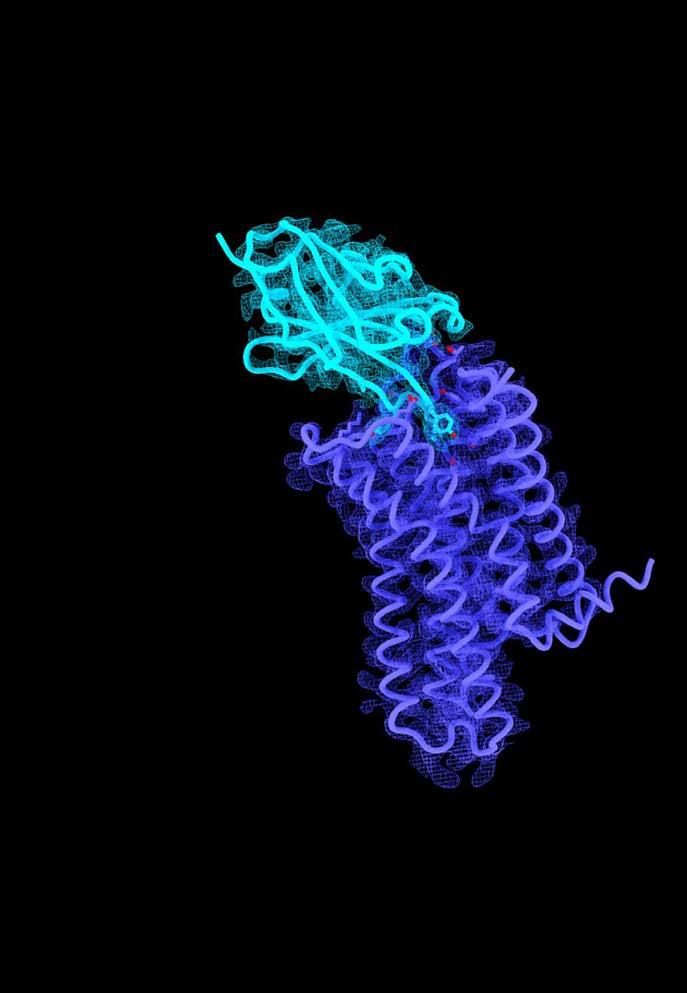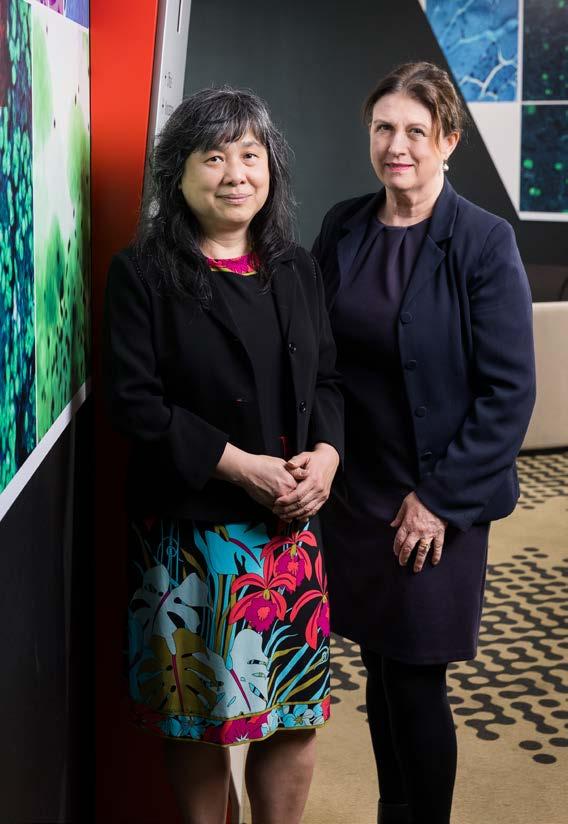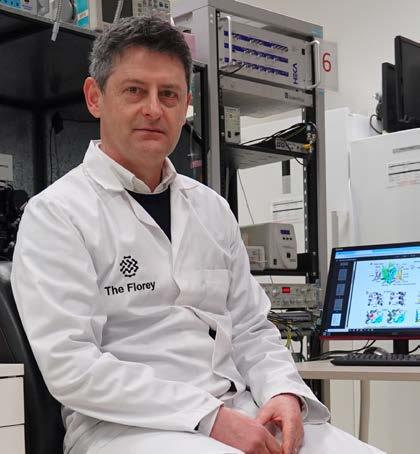Brain Matters
Your source of neuroscience and mental health insights from The Florey


Your source of neuroscience and mental health insights from The Florey


It is a great honour to serve The Florey as Executive Director, following in the footsteps of Professor Trevor Kilpatrick and the eminent leaders that preceded him.
The Florey is renowned globally as a centre of brain research excellence. It has been a delight to learn the breadth and depth of this excellence and to meet the researchers and support staff who are making this possible.
As a clinician-scientist, I have had laboratory research experience in brain repair in multiple sclerosis and imaging biomarker discovery for Alzheimer’s disease. I have had the opportunity to contribute to clinical research and to the translation of research discoveries into a start-up company. I look forward to drawing on these experiences to support Florey researchers as they advance brain research.
As highlighted in this edition of Brain Matters, neuroscience and mental health research is on an exciting trajectory. Precision medicine
holds promise for developing effective treatments for a multitude of neurological and mental health conditions. Examples include our recent discoveries for autism and the potential to identify new therapies for motor neuron disease.
The use of stem cells for brain repair offers hope for conditions such as Parkinson’s disease, and advances in brain imaging technology are enabling us to see the brain in magnificent detail and to better understand a wide range of diseases.
Progress on these and other fronts speak to a brighter future for those affected by brain and mental health conditions.
I hope that you enjoy this edition of Brain Matters and I look forward to meeting you at an upcoming event.
Professor Peter van Wijngaarden Executive Director & Chief Executive Officer
Florey MND researchers are poised to begin large-scale drug screening of potential treatments for MND thanks to a $5 million grant from the Australian Medical Research Future Fund (MRFF).
Project leader Dr Chris Bye said the work centred on world-first drug screening technology developed at The Florey.
“Motor neurone disease is a devastating, rapid and fatal neurodegenerative disease. Every day in Australia 2 people are diagnosed with MND, and 2 people die from the disease,” Dr Bye said.
“Despite almost 200 drugs
reaching human trials in the past 25 years, we still have no effective treatment. Our technology aims to disrupt the usual model of drug discovery to find treatments for people with MND.”
Dr Bye said most potential MND treatments that showed promise in preclinical development had failed to work in people.
“To develop an alternative drug discovery pathway for MND, we built a library of ‘induced pluripotent stem cells’, or iPSCs, from samples donated by more than 100 people with MND, mostly with the more common ‘sporadic’ form of the disease.”
He said the iPSCs can be crafted to produce an unlimited source of cells that exhibit the disease’s key trait: dying motor neurons.
“We are then able to test whether potential treatments are able to keep motor neurons alive. We have already screened all the drugs tested in MND patients, and our results matched what was found in trials – 95 per cent did not work.”
Dr Bye said the project would improve the quality of drug trials by screening out drugs that showed promise in conventional research methods, but which the iPSC-based approach indicated may not be
Melbourne-based Alkira Bio, a new drug discovery platform company, has secured seed investment from biotech venture capitalist firm, Curie.Bio.
Alkira Bio uses its proprietary LASEREDD® technology platform to discover therapeutic antibodies directed against previously out of reach targets, pioneering new possibilities for drug discovery.
The seed financing from Curie.Bio recognises Alkira Bio’s advanced understanding in targeting complex membrane proteins called G proteincoupled receptors (GPCRs) and the unique capability and potential of the platform.
Florey researcher turned Alkira Bio’s Chief Executive Officer, Associate Professor Daniel Scott, has studied GPCRs for over two decades to understand how they can be better targeted for drug discovery.
“We’re excited to be partnering with Curie.Bio, who recognise the potential of our technology to deliver new therapeutics unlike any existing drug.”
Curie.Bio’s team of drug hunters and drug makers will facilitate the program, with the goal of helping founders reach value-creating milestones in a rapid and capital efficient manner so that founders retain the economic upside in their companies.
Florey researcher and Alkira Bio’s Chief Scientific Officer, Dr Chris Draper-Joyce, welcomes the seed investment and partnership.
“The investment from Curie.Bio will enable us to leverage our antibody discovery platform to tackle important diseases,” said Dr Draper-Joyce.
“Our ultimate goal is to discover medications that have the potential to transform the lives of patients, and the Curie.Bio team is the right partner to co-pilot this drug discovery journey.”
Emeritus Director of The Florey, Professor Trevor Kilpatrick, added that this was a watershed moment for spin-outs at The Florey.
“A vital part of bringing important research to global markets is looking at how we commercialise it, and to
do that researchers have to think like founders. It’s not always easy, but The Florey has looked to support Alkira Bio at every step to do that,” said Prof Kilpatrick.
“Now we can look forward to seeing our science having a positive impact on patients in need of new, improved treatments.”
effective in people.
“Our breakthrough technology has the potential to revolutionise drug discovery for sporadic MND. We will be using it to conduct an unprecedented large-scale program of drug screening across high-value disease targets in MND.”
He said the team was now uniquely positioned to deliver genuine therapeutics to clinical trial for people with MND.
“As well as this MRFF funding, we’re supported by FightMND – who provided early funding to create the platform – as well as a team of leading MND clinicians, scientific experts and key industry leaders,” Dr Bye said.
Health Minister, Mark Butler, said “the government is proud to support this innovative Australian research, which may unlock the potential for stem cell technologies to find an effective treatment for MND”.

Antibodies and G protein-coupled receptors in LASEREDD® platform

Research published in Nature Communications, led by Florey scientists Dr Wah Chin Boon and Professor Anne-Louise Ponsonby, has uncovered more about the link between autism and exposure to plastic chemical bisphenol A (BPA) in the womb.
Professor Ponsonby said the researchers analysed two large birth cohorts – the Barwon Infant Study (BIS) in Australia and the Columbia Centre for Children’s Health and Environment in the USA.
“Exposure to plastic chemicals during pregnancy has already been shown in some studies to be associated with subsequent autism in offspring,” Professor Ponsonby said.
“Our work is important because it demonstrates one of the biological mechanisms potentially involved. BPA can disrupt hormone controlled male fetal brain development in several ways, including silencing a key enzyme, aromatase.”
The study examined children with lower levels of the enzyme aromatase, which in the brain converts
testosterone to neuroestrogen, Professor Ponsonby said.
The link between BPA presence and autism was particularly evident in the top fifth of boys with vulnerability to the endocrine-disrupting properties of this chemical.
The study found boys in that group, who were born to mothers with higher urinary BPA levels in late pregnancy were:
• 3.5 times more likely to have autism symptoms by age 2 years.
• 6 times more likely to have a verified autism diagnosis by age 11 years than those whose mothers had lower levels of BPA during pregnancy.
• In both birth cohorts, mechanistic evidence demonstrated higher BPA levels were associated with epigenetic (gene switching) suppression of the aromatase enzyme overall.
In laboratory work, Dr Boon studied the impact of prenatal BPA on mice.
“We found that BPA suppresses the aromatase enzyme and is associated with anatomical, neurological and behavioural changes in the male mice that may be consistent with autism,” Dr Boon said.
“This is the first time a biological pathway has been identified that might help explain the connection between autism and BPA,” she said.
Professor Ponsonby said BPA, similar bisphenols and other plastic chemicals with endocrine-disrupting effects are now widespread and almost impossible for individuals to avoid.
“We all ingest plastic chemicals in many ways – through ingesting plastic food and drink packaging, inhaling home renovation fumes, and through the skin from sources such as cosmetics. There are so many ways these chemicals enter our bodies, so, it’s not surprising that BPA was present in a large proportion of the women’s urine samples we studied. It’s important for us to understand how these plastics affect our health,” Professor Ponsonby said.
A Florey study has found that while some medical conditions appear to increase our likelihood of developing Alzheimer’s disease, others appear to decrease the odds.
The study, led by Dr Yijun (Nicholas) Pan and Dr Liang Jin, analysed data from 2,443 older Australians living in Melbourne or Perth who are part of the Australian Imaging, Biomarker, and Lifestyle (AIBL) study, an internationally recognised cohort for dementia research.
“We found anxiety and other neurological disorders are associated with increased likelihood of Alzheimer’s disease,” Dr Pan said.
“People with anxiety and neurological disorders are 1.5 and 2.5
times more likely to have Alzheimer’s disease. For people with anxiety, males have higher odds than females of developing Alzheimer’s disease.”
The study, published in Alzheimer’s and Dementia: Diagnosis, Assessment and Disease Monitoring, found several medical conditions are linked to lower odds of Alzheimer’s disease, such as arthritis, cancer, gastric complaints, and high cholesterol.
According to Dr Pan, the reasons for the connections were complex. p53, a gene regulator, that is known to play a role in a variety of cancers is also implicated in the death of neurons in Alzheimer’s disease and could explain the link.
The AIBL study reported no
significant association was observed between depression, falls or stroke and Alzheimer’s disease.
Dr Pan said the research provided a useful insight into the complex links between Alzheimer’s disease and other health conditions.
“This is the first study to assess 20 comorbidity associations with cognitive impairment using a single Australian dataset, which allowed us to fully consider how these conditions affect the likelihood of developing Alzheimer’s disease.
“We also studied whether age, gender, smoking, education, alcohol consumption, and the APOE gene – believed to be connected to Alzheimer’s – affects these

These findings are now feeding into public safety regulators which update safety recommendations on manufactured chemical exposure, including plastic chemicals, during pregnancy and early life.

associations. Our study indicates a new opportunity for biologists to study the links between these 20 conditions with Alzheimer’s disease.
“This work also provides valuable evidence to clinicians, which may help them to evaluate a patient’s risk of developing Alzheimer’s disease,” Dr Pan said.
Florey researchers have discovered how a rare genetic mutation breaks a molecular ‘gate’, causing the severely disabling developmental and epileptic encephalopathy (DEE) in infants.
Florey biophysicist Dr Géza Berecki said DEE was a devastating condition that can start soon after birth, leading to severe disability or death.
“Sodium channels are large proteins located in the membranes of neurons that possess a mechanism that works a bit like a self-closing gate,” Dr Berecki said.
“In healthy individuals, this cellular gate briefly opens then shuts automatically to prevent sodium ions from continuously flowing into neurons. We have discovered that in certain forms of DEEs – caused by mutations in the gene encoding the neuronal sodium Nav1.2 – the gate is always open, allowing the ions to flow continuously, leading to seizures.”
The significant discovery is outlined in a paper published in Brain
Dr Berecki, the paper’s first author, said precisely-timed sodium ion flow into neurons is part of normal brain signalling, but this is the first time researchers have shown that SCN2A mutations can cause uninterrupted sodium ion flow into neurons, leading to seizures.
“We worked with data of DEE patients in Australia and overseas, conducting experiments to measure neuronal function in cell samples and computer simulations of the mutation-affected protein,” said Dr. Berecki, from The Florey’s Ion Channels and Human Diseases Group.
“We found that the mutation in SCN2A that causes DEE disrupts fast inactivation of the Nav1.2 channel. This disrupts the brain’s ability to shut down neuronal signals, causing an overall increase in brain excitability.”
SCN2A is a very large gene which means it has immense potential for genetic variation. The number of known SCN2A mutations continues to grow as gene sequencing becomes more widespread.
Dr Berecki said that The Florey’s extensive research into genetic epilepsies, including SCN2A, not only deepens our understanding of ion channel diseases but also uncovers crucial new molecular interactions essential for the fast inactivation process in Nav1.2 channels.
“While these insights are significant for advancing fundamental science, they also hold promising therapeutic implications. Drugs capable of modifying the Nav1.2 inactivation mechanism may pave the way for more effective personalised treatment strategies for affected individuals,” Dr Berecki said.


Exploration into the apolipoprotein E (APOE) gene by Florey researchers has the potential to dramatically improve treatment for people with all subsets of Alzheimer’s disease.
With multi-year grants from the Johnstone Family Foundation and the Alzheimer’s Association, worth almost $500,000, Dr Abdel Ali Belaidi, a Senior Research Fellow at The Florey, aims to develop treatment strategies for Alzheimer’s disease based on APOE and mRNA technology. The proposed treatment emerged from understanding the functions of the APOE gene, which is the strongest risk factor for late onset Alzheimer’s and exists in three common forms. The
protective form, APOE2, and the risk form, APOE4, have been known for decades, but Dr Belaidi believes only few research studies have dedicated time to understanding the function of those forms in the brain.
Dr Abdel Belaidi says the funding he has received is crucial for earlystage research.
“This funding allows us to do the testing and generate the preliminary data needed to show this project is likely to succeed if it were to scale up.”
Hailing from a background in biochemistry, Dr Belaidi first became interested in neurodegeneration after his work with molybdenum cofactor deficiency, a rare and fatal disease with a high infant mortality rate. In 2009, the first successful treatment
of the disease was reported in Melbourne, with a baby at the Monash Children’s Facility, of which Dr Belaidi related his small role as part of the team developing the therapy.
From there, he developed a method to quantify a toxic substance built in the blood and urine of patients suspected of having the condition. This research became the direct foundation towards a working therapy for molybdenum cofactor deficiency type A, a significant milestone which was published in The Lancet journal and then approved by the FDA.
“This is where my interest in neurodegeneration started,”
Dr Belaidi said.
“Our success in developing a curative treatment for this devastating metabolic disease was based on better understanding of the protein biology.”
“I believe that this is the key to developing disease-modifying therapies for neurodegenerative diseases such as Alzheimer’s disease.”
In 2014, when Dr Belaidi first shifted his focus to Alzheimer’s, the research in the field was primarily focused on finding treatment to target the amyloid beta pathway.
“The field is not where it was years ago. When I first joined everyone was thinking unilaterally –getting rid of the peptide amyloid aggregates from the brain was the key to curing the disease,” he said.
“The thinking right now is that we should have combination therapies focusing on multiple targets, because it’s very unlikely that one single target will achieve the cure for the disease.”
The project will utilise a mRNAbased approach; a technology made popular by the development of vaccines during the COVID pandemic. The mRNA acts as a messenger, providing an instruction manual for our cells to create a protein. But the biggest challenge to tackle is the delivery of mRNA to the brain. The project hopes to solve this by creating a method which will allow the mRNA to cross the blood brain barrier and bring it into the brain to express different proteins capable of preventing neuronal death.
“We think that here in The Florey, we have the tools and the expertise to overcome this challenge and use mRNA-based therapeutics for Alzheimer’s disease. This is what we are trying to do.”
While there have been modest results emerging from the amyloidbased therapies, wider interest has shifted towards the role of APOE in Alzheimer’s disease and Dr Belaidi hopes the project will eventually transition to clinical trials.
“We’re grateful for the generosity of our donors to have enabled us to bring this idea off the ground and hopefully change the course of Alzheimer’s disease,” he said.

Week panel: Professor Leeanne Carey, Professor Dominique Cadilhac, Professor Vincent Thijs, and Brooke Parsons.
The Florey hosted our first public lecture of 2024 titled ‘Unlocking hearts and minds’ in April as part of national Heart Week.
Expert researchers spoke on the vital topic of heart health, including breakthroughs and valuable insights on treating and preventing brain and kidney complications arising from heart surgery and heart failure.
Held at the Ian Potter Auditorium in June 2024, The Florey’s public lecture named ‘New approaches to mental health treatments’ brought together experts to discuss the current treatments available for anxiety, depression, schizophrenia and bipolar disorder, with topics involving the contribution of lifestyle factors to mental health conditions, how we can develop smarter medications and how we can repurpose existing treatments.
Stroke Week: Research innovations in treatment and recovery
The Florey’s Stroke Week panel delved into the intricacies of stroke care, spanning from acute intervention to long-term rehabilitation. Our speakers, which included those pictured above, discussed the continuum of stroke care and the collaborative efforts for advancing research and clinical practices.
Wednesday 9 October, 10.30am–11.30am Kenneth Myer Building, Parkville

Kate Brown has had a long career in medical research. From working fresh out of high school for a large diagnostic laboratory to becoming a trainer of medical laboratory technicians, her long association with the industry has given her a strong appreciation of the critical work being undertaken at The Florey.
It was during her tenure at RMIT’s Department of Health Sciences in the early 1970s, training technicians around the Parkville precinct, that Kate first became aware of The Florey.
Her vested interest has continued to this day, and while recognising that many areas of research are critical, she is particularly supportive of The Florey’s research into various forms of dementia.
As our population ages, an increasing number of people are affected by dementia. Kate says she knows many people who either suffer from dementia themselves or are caring for a loved one with dementia.
“I believe an early diagnosis of dementia will not only benefit individuals and their families but also our economy as well.”
Kate has generously included a gift for The Florey in her Will and regularly checks to ensure it is up to date.
The Florey’s Gift in Will supporters gathered on 19 June for this year’s latest boardroom briefing event, led by Florey researcher, Professor Anne-Louise Ponsonby. Professor Ponsonby is an epidemiologist and public health physician, and spoke on tackling the early life origins of brain and mind disorders. Discussion centred on how we can better understand the possible adverse impact of some modern chemicals,

She says, “I have confidence that my gift is highly likely to make a difference for the next generation.”
To find out more about supporting The Florey’s research through your Will, please contact our Bequest Manager, Nola Wilmot, on 1800 063 693 or philanthropy@florey.edu.au

such as those found in plastic products, on early brain development.
Have you included The Florey in your Will? Let us know you have left a gift to The Florey in your Will, and we can welcome you to Florey Society research briefings.
The Florey acknowledges the Traditional Owners of the land on which we work, the Wurundjeri people of the Kulin Nation. We pay our respects to their Elders past, present and emerging. The Florey is committed to the aims, principles and actions of marra ngarrgoo, marra goori: The Victorian Aboriginal Health, Medical and Wellbeing Research Accord.